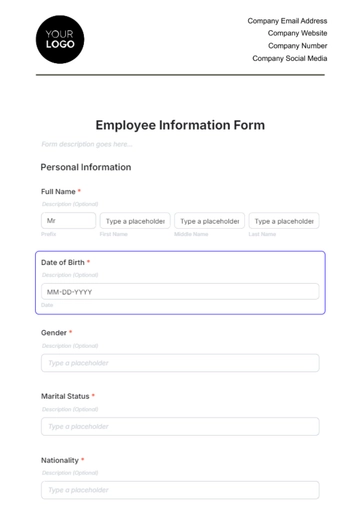Free Employee Security Awareness Policy

[Your Company Name]
Effective Date: January 10, 2065
Version: 1.0
1. Introduction
At [Your Company Name], the security of our information, networks, and systems is critical to the integrity of our business operations and the protection of our clients' and partners' data. As cyber threats continue to grow in complexity and frequency, every employee must take an active role in safeguarding our digital assets. This policy outlines our approach to security awareness and the responsibilities of all employees to minimize risks, protect sensitive data, and ensure a culture of cybersecurity vigilance.
2. Scope
This policy applies to all employees, contractors, consultants, interns, and any third parties granted access to [Your Company Name]'s digital resources. It extends to all devices, systems, networks, and applications used in the conduct of business activities.
3. Objectives
Enhance Security Culture: Foster a culture where security is integrated into everyday activities.
Reduce Human Error: Prevent security breaches caused by unintentional human actions.
Ensure Compliance: Meet industry regulations and legal requirements for employee security training (e.g., GDPR, HIPAA).
Minimize Risk: Continuously assess and mitigate risks to company systems, data, and assets.
4. Employee Responsibilities
All employees are expected to adhere to the following practices:
Complete Security Training: Employees must complete the company’s security awareness training within the first month of employment and annually thereafter.
Maintain Strong Passwords: Use complex passwords and multi-factor authentication (MFA) for accessing company systems. Passwords should not be shared or reused across platforms.
Be Vigilant Against Phishing: Recognize and avoid phishing attempts and malicious links. Verify suspicious communications with the IT team before taking any action.
Follow Data Privacy Protocols: Handle sensitive information, including customer data, with utmost care. Ensure that personal data is securely stored and transmitted.
Report Security Incidents: Any suspected security incident (e.g., malware infection, unauthorized access, suspicious emails) must be reported immediately to the [Company Name] Security Operations Center (SOC).
Adhere to Device Security Policies: Secure all company-owned devices, including mobile phones and laptops, with encryption and strong passwords. Report lost or stolen devices immediately.
5. Security Awareness Training
To support employees in fulfilling their security responsibilities, the following training protocols are in place:
Initial Training: All new employees must complete an online security awareness course within 30 days of hire, covering essential topics like password security, email safety, social engineering attacks, and data protection.
Annual Refresher Training: Employees will participate in annual security training sessions to keep up-to-date with the latest threats, tools, and security best practices.
Targeted Training: As new technologies or risks emerge, employees may receive additional specialized training, including security protocols for remote work, secure software development practices, or incident response techniques.
Gamified Learning: To enhance engagement, training modules will include interactive scenarios and simulated phishing campaigns to allow employees to practice identifying threats.
6. Incident Reporting and Response
Employees play a crucial role in detecting and reporting potential security incidents. The process is as follows:
Incident Identification: Employees should report any suspicious activity, such as phishing attempts, unusual system behavior, or data access anomalies, to the [Company Name] SOC within 24 hours.
Immediate Actions: Employees should avoid interacting with suspicious emails or files, disconnect affected devices from the network, and inform the IT team promptly.
Incident Handling: The [Your Company Name] Security team will assess, mitigate, and address reported incidents through the company’s Incident Response Plan.
7. Penalties for Non-Compliance
Failure to comply with this policy may result in disciplinary action, including, but not limited to:
Verbal or Written Warnings for minor infractions.
Mandatory Security Re-Training for recurring or significant violations.
Suspension or Termination for serious breaches, such as the intentional compromise of company systems, failure to report a security incident, or violations resulting in significant damage to the company. Disciplinary actions will be taken by the company’s internal procedures and may vary based on the severity of the infraction.
8. Continuous Improvement and Policy Review
In a rapidly changing security landscape, continuous improvement is essential. This policy will be reviewed annually, or sooner if a significant security event or regulatory change occurs. Employee feedback and incident analysis will drive improvements in training and policy updates.
Annual Review: A comprehensive review of this policy will be conducted every January to ensure that the information remains relevant and aligned with evolving threats.
Feedback Mechanism: Employees are encouraged to provide feedback on the policy and training programs to enhance effectiveness.
9. Conclusion
The success of [Your Company Name]’s security program relies on the active participation of all employees. By understanding the risks and taking proactive steps to protect our data and systems, we ensure a secure environment for both our organization and our clients.
Approval:
 [Your Company Name] Security Officer
[Your Company Name] Security Officer
Date: January 10, 2065
Acknowledgment of Receipt:
I, the undersigned, acknowledge that I have received and read the [Your Company Name] Employee Security Awareness Policy. I understand my responsibilities and agree to comply with the guidelines outlined in this policy.
Employee Name: ____________________
Employee Signature: ____________________
Date: ____________________
- 100% Customizable, free editor
- Access 1 Million+ Templates, photo’s & graphics
- Download or share as a template
- Click and replace photos, graphics, text, backgrounds
- Resize, crop, AI write & more
- Access advanced editor
Promote a culture of security with Template.net's Employee Security Awareness Policy Template. Editable and customizable, this template helps establish clear guidelines for employee behavior and training. Editable in our Ai Editor Tool, it offers an efficient way to enhance awareness and protect your organization.
You may also like
- Employee Letter
- Employee ID Card
- Employee Checklist
- Employee Certificate
- Employee Report
- Employee Training Checklist
- Employee Agreement
- Employee Contract
- Employee Training Plan
- Employee Incident Report
- Employee Survey
- Employee of the Month Certificate
- Employee Development Plan
- Employee Action Plan
- Employee Roadmap
- Employee Poster
- Employee Form
- Employee Engagement Survey





























